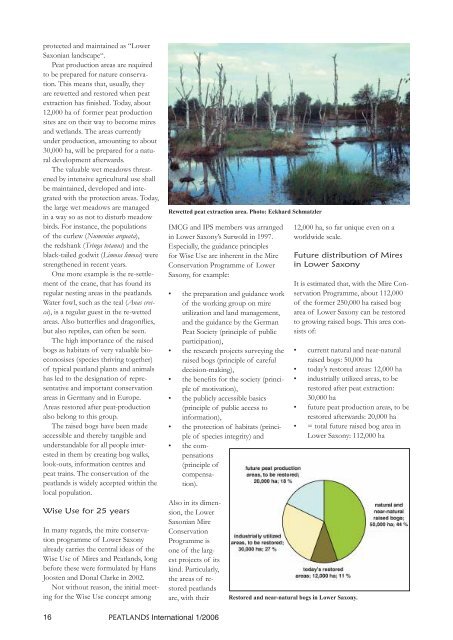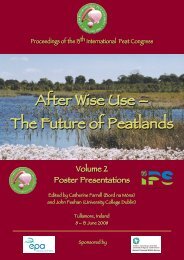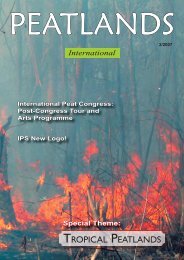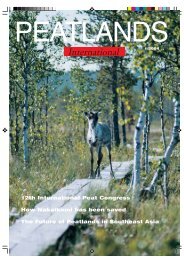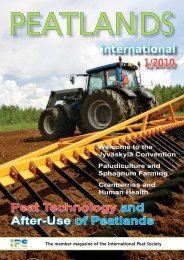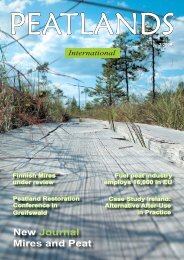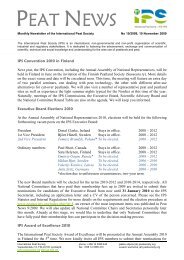peatlands 1 taitto.indd - International Peat Society
peatlands 1 taitto.indd - International Peat Society
peatlands 1 taitto.indd - International Peat Society
You also want an ePaper? Increase the reach of your titles
YUMPU automatically turns print PDFs into web optimized ePapers that Google loves.
protected and maintained as “Lower<br />
Saxonian landscape“.<br />
<strong>Peat</strong> production areas are required<br />
to be prepared for nature conservation.<br />
This means that, usually, they<br />
are rewetted and restored when peat<br />
extraction has fi nished. Today, about<br />
12,000 ha of former peat production<br />
sites are on their way to become mires<br />
and wetlands. The areas currently<br />
under production, amounting to about<br />
30,000 ha, will be prepared for a natural<br />
development afterwards.<br />
The valuable wet meadows threatened<br />
by intensive agricultural use shall<br />
be maintained, developed and integrated<br />
with the protection areas. Today,<br />
the large wet meadows are managed<br />
in a way so as not to disturb meadow<br />
birds. For instance, the populations<br />
of the curlew (Numenius arquata),<br />
the redshank (Tringa totanus) and the<br />
black-tailed godwit (Limosa limosa) were<br />
strengthened in recent years.<br />
One more example is the re-settlement<br />
of the crane, that has found its<br />
regular nesting areas in the <strong>peatlands</strong>.<br />
Water fowl, such as the teal (Anas crecca),<br />
is a regular guest in the re-wetted<br />
areas. Also butterfl ies and dragonfl ies,<br />
but also reptiles, can often be seen.<br />
The high importance of the raised<br />
bogs as habitats of very valuable bioeconosises<br />
(species thriving together)<br />
of typical peatland plants and animals<br />
has led to the designation of representative<br />
and important conservation<br />
areas in Germany and in Europe.<br />
Areas restored after peat-production<br />
also belong to this group.<br />
The raised bogs have been made<br />
accessible and thereby tangible and<br />
understandable for all people interested<br />
in them by creating bog walks,<br />
look-outs, information centres and<br />
peat trains. The conservation of the<br />
<strong>peatlands</strong> is widely accepted within the<br />
local population.<br />
Wise Use for 25 years<br />
In many regards, the mire conservation<br />
programme of Lower Saxony<br />
already carries the central ideas of the<br />
Wise Use of Mires and <strong>Peat</strong>lands, long<br />
before these were formulated by Hans<br />
Joosten and Donal Clarke in 2002.<br />
Not without reason, the initial meeting<br />
for the Wise Use concept among<br />
16 PEATLANDS <strong>International</strong> 1/2006<br />
Rewetted peat extraction area. Photo: Eckhard Schmatzler<br />
IMCG and IPS members was arranged<br />
in Lower Saxony’s Surwold in 1997.<br />
Especially, the guidance principles<br />
for Wise Use are inherent in the Mire<br />
Conservation Programme of Lower<br />
Saxony, for example:<br />
•<br />
•<br />
•<br />
•<br />
•<br />
•<br />
the preparation and guidance work<br />
of the working group on mire<br />
utilization and land management,<br />
and the guidance by the German<br />
<strong>Peat</strong> <strong>Society</strong> (principle of public<br />
participation),<br />
the research projects surveying the<br />
raised bogs (principle of careful<br />
decision-making),<br />
the benefi ts for the society (principle<br />
of motivation),<br />
the publicly accessible basics<br />
(principle of public access to<br />
information),<br />
the protection of habitats (principle<br />
of species integrity) and<br />
the compensations<br />
(principle of<br />
compensation).<br />
Also in its dimension,<br />
the Lower<br />
Saxonian Mire<br />
Conservation<br />
Programme is<br />
one of the largest<br />
projects of its<br />
kind. Particularly,<br />
the areas of restored<br />
<strong>peatlands</strong><br />
are, with their<br />
12,000 ha, so far unique even on a<br />
worldwide scale.<br />
Future distribution of Mires<br />
in Lower Saxony<br />
It is estimated that, with the Mire Conservation<br />
Programme, about 112,000<br />
of the former 250,000 ha raised bog<br />
area of Lower Saxony can be restored<br />
to growing raised bogs. This area consists<br />
of:<br />
•<br />
•<br />
•<br />
•<br />
•<br />
current natural and near-natural<br />
raised bogs: 50,000 ha<br />
today’s restored areas: 12,000 ha<br />
industrially utilized areas, to be<br />
restored after peat extraction:<br />
30,000 ha<br />
future peat production areas, to be<br />
restored afterwards: 20,000 ha<br />
= total future raised bog area in<br />
Lower Saxony: 112,000 ha<br />
Restored and near-natural bogs in Lower Saxony.


